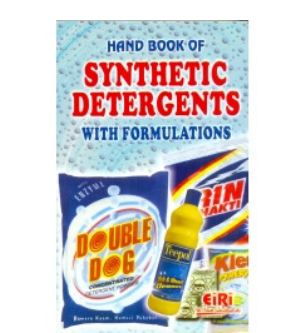‘Liquid Detergent Making Formula’ PDF Quick download link is given at the bottom of this article. You can see the PDF demo, size of the PDF, page numbers, and direct download Free PDF of ‘Detergent Formulation Book’ using the download button.
Hand Book of Synthetic Detergents Book PDF Free Download

Detergent Formulation
COMMON DETERGENT INGREDIENTS
Modern detergents can comprise 20 or more ingredients depending on what benefits
the detergent is meant to deliver.
It is not within the scope of this chapter to provide an extensive review of the myriad ingredients used in detergent formulations.
Rather, the intent of this section is to provide a general overview of the more common elements— surfactants, dispersing polymers, builders and chelants, bleaching systems, solvents.
And performance enhancing minors — in order to familiarize the reader with the general chemistry of detergent formulation.
Subsequent chapters will provide significantly more detail on many of these ingredients and there are several reference books available on the topic [6–12].
Surfactants Surfactants are arguably the most common ingredient of the detergent formulations described in this book.
Their primary function is to modify the interface between two or more phases in order to promote the dispersion of one phase into another.
In cleaning formulations, for example, surfactants serve to wet surfaces and reduce the nterfacial tension between soil and water such that the soil is removed from the surface to be cleaned and dispersed in the aqueous phase.
The ability of surfactants to concentrate at interfaces derives rom their amphiphilic character—the combination of hydrophilic and hydrophobic moieties within the same molecule.
Generally, surfactants are classified according to their hydrophilic component as nonionic, anionic, cationic, or amphoteric.
The nonionic surfactants have a hydrophilic component that is not ionized. Typical nonionic groups consist of polyoxyethylene, polyoxypropylene, alkanolamides, or sugar esters.
As the name implies, the hydrophilic component of anionic surfactants comprises an anionic group, typically a sulfate, sulfonate, or carboxylate moiety.
Likewise, the cationic surfactants comprise molecules containing a positively charged group such as a quaternary amine.
The amphoteric surfactants are perhaps the most unique in that they comprise a hydrophilic group containing both anionic and cationic character such as the amino acids.
Typical hydrophobes for surfactants are the alkyl chains between C10 and C20.
However, in some specialty surfactants the hydrophobe may consist of polysiloxane or Until the 1940s detergents were formulated principally with the sodium or potassium salts of C12–C18 chain length fatty acids.
The synthesis of surfactants from petroleum feed stocks in the late 1940s spurred the velopment of soap-free synthetic detergents that proved much more effective for cleaning in cooler wash temperatures and in hard water.
Today, the linear alkyl benzene sulfonates, alkyl sulfates, alkyl ethoxy sulfates, and alkyl ether ethoxylates are the workhorse surfactants for most detergent formulations.
Alkyl polyglucosides, alkyl glucosamides, and methyl ester sulfonates are also widely
used [13].
Recent attention has been given to the use of internal methyl branched alkyl chains as the hydrophobe for certain anionic surfactants [14].
Such branching promotes improved solubility, particularly in cold, hard water.
For systems where water is not the continuous phase a variety of specialty surfactants are used.
Examples include the polydimethylsiloxane-based surfactants for use in highly hydrophobic media and the acrylate-polystyrene co-polymers designed by DiSimone and colleagues for applications in cleaning systems utilizing condensed phase CO2 [15].
Dispersing Polymers The suspension of solids or liquids in a continuous phase is a critical aspect in the formulation of paints, inks, coatings, and agricultural products such as herbicides.
I. GROUPS OF Synthetic DETERGENTS :
- Classification
- Anionic Detergents
- Alkyl Aryl Sulphonates
- Long-Chain (Fatty) Alcohol Sulphates
- Sulphonated Olefins
- Sulphated Monoglycerides
- Sulphated Ethers
- Sulphosuccinates
- Sulphonated Methyl Esters
- Alkane Sulphonates
- Phosphate Esters
- Alkyl Isethionates
- Acyl Sarcosides
- Alkyl Taurides
- Fluoro Surfactants
- Cationic Detergents
- Non-ionic Detergents
- Fatty Alcohol and alkyl Phenol Condensates
- Fatty Acid Condensates
- Condensation of Ethylene Oxide with an Amide
- Block Polymers
- Sucrose Esters
- Sorbitan Esters
- Alkylolamides
- Fatty Amine Oxides
- Amphoterics and Zwitterionics
- Biodegradability
- II. Synthesis OF DETERGENTS :
- Raw Materials for Anionic Synthetic Detergents
- Fatty Alcohols, Natural and Synthetic
- Olefins
- Alpha Olefins
- Linear Internal Olefins
- Normal Paraffins
- Alkyl Benzene
- Methyl Esters
- Sulphonation of Detergent Raw Materials
- The Inorganic Raw Materials for Sulphonation
- Sulphuric Acid and Oleum (Fuming Sulphuric Acid)
- Sulphur Trioxide from Oleum Stripping
- Sulphur
- Chlorosulphonic Acid
- Sulphamic Acid
- Sulphonation with Sulphuric Acid and/or Oleum
- Sulphonation with Sulphur Trioxide
- Sulphonation Processes
- Alpha Olefin Sulphonates (AOS)
- Methyl Ester Sulphonates
- Heavy Alkylate Sulphonates
- Sulphonation with Chlorosulphonic Acid
- Sulphation by Means of Sulphamic Acid
- Sulphosuccinates and Sulphosuccinamates
- Alkane (Paraffin) Sulphonates
- Phosphate Esters
- Non-ionic Detergents
- Ethylene and Propylene Derivatives
- Fatty Acid Alkanolamides
- Cationic Detergents
- Cationic Surtace Active Agents
- Amphoteric Detergents
- III. MANUFACTURE OF FINISHED DETERGENTS :
- Powder Detergents
- Simple Absorption
- Combined Absorption and Neutralisation
- Dry Mixing of Powders
- Spray-drying of Powders
- Colour
- Particle Size and Spread
- Bulk Density
- Residual Moisture
- Stickiness
- Product Uniformity
- Separation of Powder
- Wet Scrubbing
- Use of Fines
- Combination of Spray-dried and Dry-mixed Powders
- Ballestra ‘Combex’ System
- Patterson-Kelley System
- Anhydro System
- Drum-drying of Powders
- Liquid Detergents
- Toilet Preparations
- Paste Detergents
- Calcium Sulphonates
- Solid Detergents
- Detergents Toilet Bars
- Household Scrub Bars
- Fabric Softeners
- Abrasive Cleaners
- IV. FORMULATION AND APPLICATION OF DETERGENTS :
- Introduction
- Foam
- Household Cleaning
- Heavy-duty Laundering
- Foam Control
- Light-duty Household Products
- General Purpose Detergents
- Choice of Non-ionic
- Concentrated Powders
- Cold Water Washing
- Hard-Surface Cleaners
- Machine Dishwashing
- Abrasive-type Cleaners
- Miscellaneous Household Cleaners
- Commerical Laundering
- Solvent Detergents
- Carpet and Upholstery Cleaners
- Textile Dressing
- Mercerizing
- Food and Dairy Industries
- Detergent Sanitisers
- Metal Cleaners
- Miscellaneous Cleaners
- Lavatory Cleaner
- Hand Cleansers
- Waterless Hand Cleaners
| Author | – |
| Language | English |
| No. of Pages | 15 |
| PDF Size | 03 MB |
| Category | Literature |
| Source/Credits | 3.imimg.com |
Related PDFs
Voltas Water Cooler Catalogue 2023 PDF
Hand Book of Synthetic Detergents Book PDF Free Download
